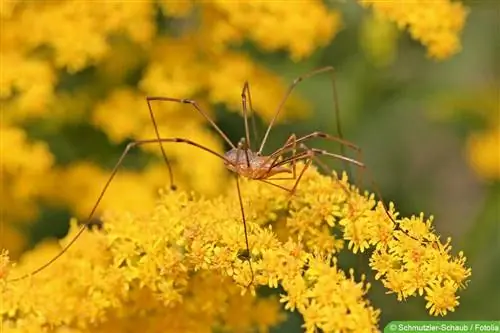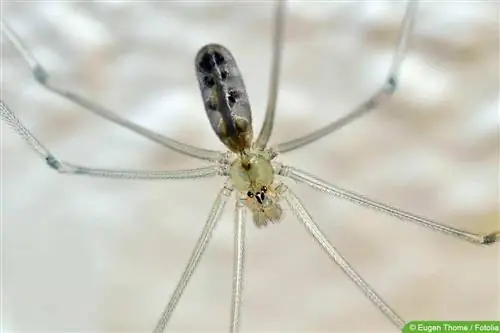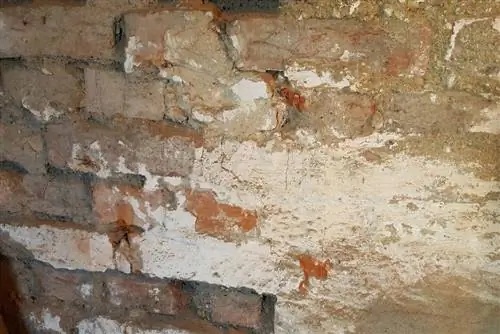- Author admin [email protected].
- Public 2023-12-17 03:39.
- Last modified 2025-01-24 12:45.
Long, thin legs and a delicate body characterize the trembling spider. She prefers apartments as a living space. Although useful, not everyone likes this shared apartment. How to fight the intruder?
Trembling Spider
Everyone knows it, because the large trembling spider (Pholcus phalangioides) can be found in almost every house. It lives in the basement or in the apartment behind curtains, under cupboards or beds. The spider species is found almost all over the world. The small trembling spider (Pholcus opilionoides) is very rare in our latitudes. Small and large trembling spiders belong to the family of real web spiders. The spider gets its name from the fact that it swings back and forth in the web when threatened. In this way she irritates her attacker. He can no longer see their outline exactly and looks for another prey.
Note:
For many people, the bizarre insect is frightening. Here we can give the all-clear. Pholcus phalangioides is completely harmless to humans!
Features
- Coloring: gray-white or yellowish, partly transparent
- Height: 10 millimeters
- Leg length: 50 millimeters
- eight legs
- extremely thin
- nocturnal
Huge Nets
The small animals are able to weave very large, irregular webs in three dimensions. The spider webs appear unstructured. Long holding threads are noticeable.
Useful spider species
Before you try to banish the delicate spiders from the house or even fight them with chemicals, you should get to know their useful properties. Trembling spiders catch mosquitoes, flies and woodlice in their webs and eat them.

Note:
Be sure to avoid killing the delicate spiders. They protect us from pests, serve as food for birds and small animals and make an important contribution to preserving the ecosystem. When mosquitoes become a nuisance in summer, trembling spiders are a great help.
Get rid of trembling spiders
If you discover a Pholcus phalangioides in your home, don't be alarmed. The insect is not poisonous, it does not bite or sting.
Catch with a glass
Instructions:
- Put a glass over the spider.
- Take a piece of paper. Try sliding this under the glass opening.
- Take the caught spider to the garden.
Catch with the spider catcher
If you often encounter spiders in your home, you can get rid of them with a so-called spider catcher. These consist of two brush parts that fit together like pliers. With this device spiders can be caught unharmed and released into the open.
By the way, it can happen that the trembling spider loses a leg if you try to carry it outside in a jar or with the spider catcher. This reaction is used by many species of spiders when in danger to irritate their enemies and escape from them. The legs have a predetermined breaking point. Pholcus phalangioides can live for a long time even with five or six legs.
Note:
Don't vacuum up the useful spiders. They wouldn't survive.
Defend
Specialist retailers offer anti-spider plugs to ward off the species of spiders that are often found in houses. These are easy to use, you just plug them into the socket. The devices emit unpleasant sounds for spiders, but these are not perceptible for humans. After a while the rooms are free of spiders.
Prevention
If you close your windows with insect screens in summer, you prevent spiders and insects from entering, which they use as food. Rooms where there are no mosquitoes, flies or other creepy crawlies are uninteresting for trembling spiders. They will quickly run away. Clean your apartment with vinegar cleaner every now and then. The smell is unpleasant for many insects. This way mosquitoes, flies and spiders stay away.
Tip:
Not only the smell of vinegar, but also citrus scents banish insects from the house and prevent them from becoming a plague. Place lemon slices on a plate. Enjoy the fresh scent and look forward to the insect-free apartment.
Remove the spider webs regularly. Seal the cracks and gaps in window frames and in the floor. The spiders use these routes to get into living spaces. In the dark, close the windows and doors of lit rooms.
Confidently similar

Pholcus phalangioides is often confused with the harvestman. Their delicate physique and long, thin legs are similar. However, the harvestman is rarely found in apartments. He doesn't build networks. In contrast to the harvestman, trembling spiders have a two-part body.






